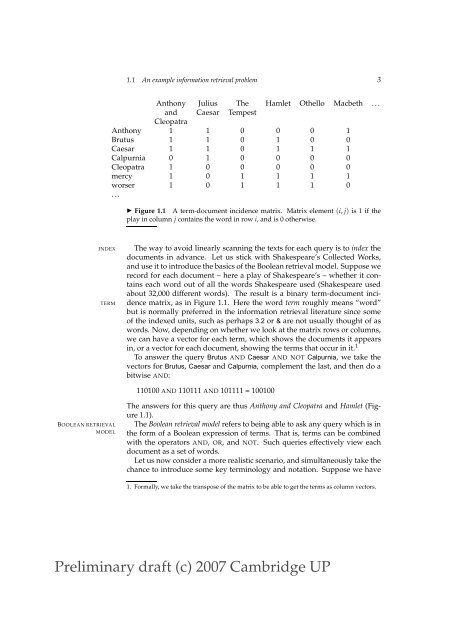Preliminary draft (c) 2007 Cambridge UP - Villanova University
Preliminary draft (c) 2007 Cambridge UP - Villanova University
Preliminary draft (c) 2007 Cambridge UP - Villanova University
Create successful ePaper yourself
Turn your PDF publications into a flip-book with our unique Google optimized e-Paper software.
1.1 An example information retrieval problem 3<br />
Anthony Julius The Hamlet Othello Macbeth . . .<br />
and Caesar Tempest<br />
Cleopatra<br />
Anthony 1 1 0 0 0 1<br />
Brutus 1 1 0 1 0 0<br />
Caesar 1 1 0 1 1 1<br />
Calpurnia 0 1 0 0 0 0<br />
Cleopatra 1 0 0 0 0 0<br />
mercy 1 0 1 1 1 1<br />
worser 1 0 1 1 1 0<br />
. . .<br />
◮ Figure 1.1 A term-document incidence matrix. Matrix element (i, j) is 1 if the<br />
play in column j contains the word in row i, and is 0 otherwise.<br />
INDEX<br />
TERM<br />
The way to avoid linearly scanning the texts for each query is to index the<br />
documents in advance. Let us stick with Shakespeare’s Collected Works,<br />
and use it to introduce the basics of the Boolean retrieval model. Suppose we<br />
record for each document – here a play of Shakespeare’s – whether it contains<br />
each word out of all the words Shakespeare used (Shakespeare used<br />
about 32,000 different words). The result is a binary term-document incidence<br />
matrix, as in Figure 1.1. Here the word term roughly means “word”<br />
but is normally preferred in the information retrieval literature since some<br />
of the indexed units, such as perhaps 3.2 or & are not usually thought of as<br />
words. Now, depending on whether we look at the matrix rows or columns,<br />
we can have a vector for each term, which shows the documents it appears<br />
in, or a vector for each document, showing the terms that occur in it. 1<br />
To answer the query Brutus AND Caesar AND NOT Calpurnia, we take the<br />
vectors for Brutus, Caesar and Calpurnia, complement the last, and then do a<br />
bitwise AND:<br />
110100 AND 110111 AND 101111 = 100100<br />
BOOLEAN RETRIEVAL<br />
MODEL<br />
The answers for this query are thus Anthony and Cleopatra and Hamlet (Figure<br />
1.1).<br />
The Boolean retrieval model refers to being able to ask any query which is in<br />
the form of a Boolean expression of terms. That is, terms can be combined<br />
with the operators AND, OR, and NOT. Such queries effectively view each<br />
document as a set of words.<br />
Let us now consider a more realistic scenario, and simultaneously take the<br />
chance to introduce some key terminology and notation. Suppose we have<br />
1. Formally, we take the transpose of the matrix to be able to get the terms as column vectors.<br />
<strong>Preliminary</strong> <strong>draft</strong> (c)<strong>2007</strong> <strong>Cambridge</strong> <strong>UP</strong>



